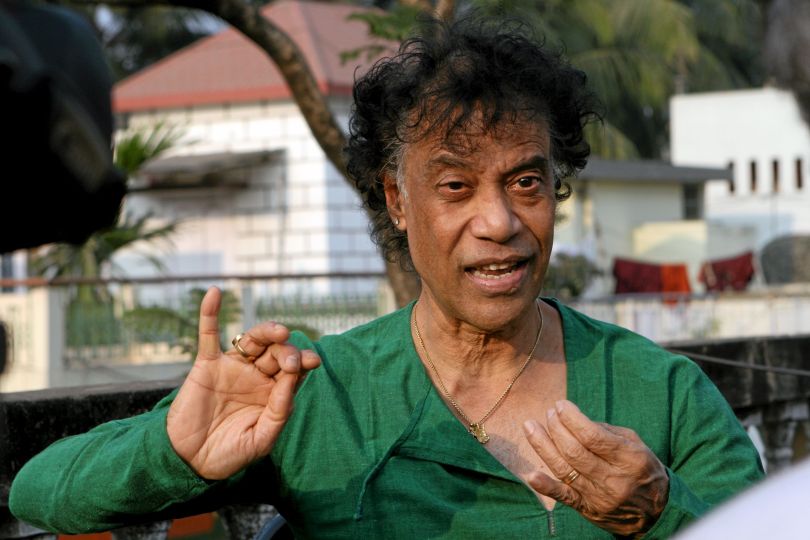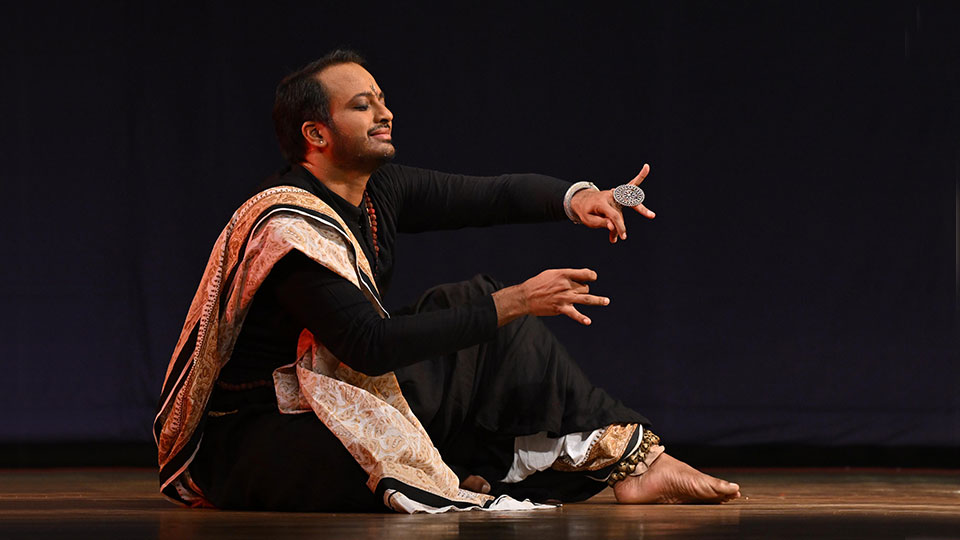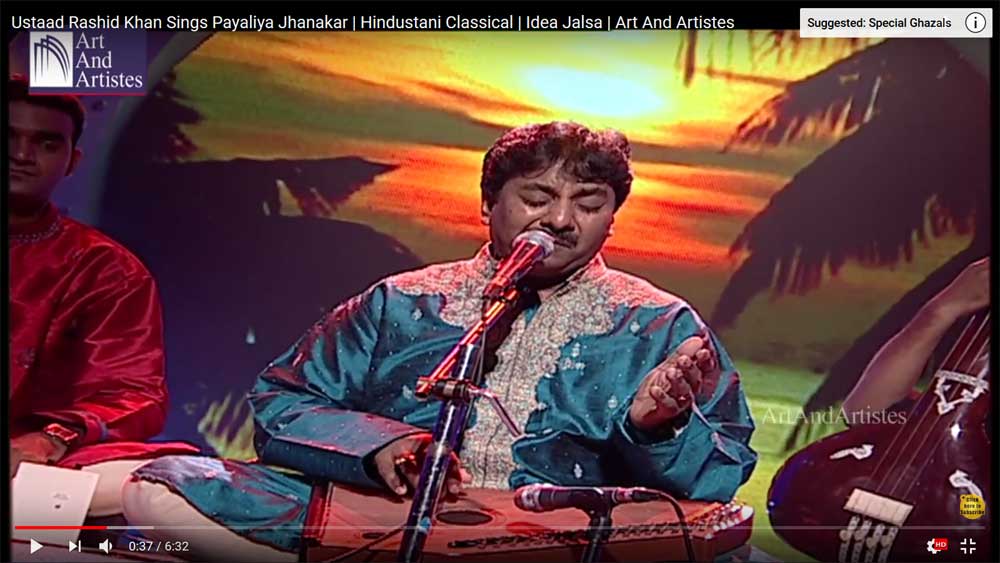From the ‘baiji’ streets of Bowbazaar in Kolkata to the plush platforms of San Francisco, Pt.Chitresh Das has literally seen it all. His Kathak journey is extremely inspiring and commendable. A small frame, lean, with a dusky complexion and a crown of dark curly hair – Chitresh ji always exuded energy and flamboyance that he wore like his skin. Chitresh ji grew up in his parents’ dance school in Calcutta ( Nritya Bharati) in a ‘mahaul’ (ambience) any artist would crave for: surrounded by great literary artists, poets, dancers, and gurus of the times like the legendary Shambhu Maharaj who visited to teach his father, Uday Shankar, Balasaraswati, Rukmini Devi Arundale etc. On his mother’s insistence, he began learning Kathak under Pt. RamNarayan Mishra (Kolkata), in the virtuous style of Jaipur gharana as well as the lyrical Lucknow gharana. Unlike most of the Gurus, he formally studied dance and earned his Masters in dance from Prayag Sangeet Samiti, Allahabad. And in a way, his learning never stopped, as he travelled the world, collaborated with artists from the world over of different art media.

I had, of course, heard of Pt. Chitresh Das, specifically his concept of ‘Kathak Yoga’ and his encounter with tap dance. So, in 2008, when he was touring with ‘Kathak-Jazz Suites’ accompanied by Jason Samuels Smith, the famous tap dancer (Emmy award winner), I jumped on this rare opportunity and went to Mumbai. I was young into Kathak then, and to me watching Kathak fused with Jazz was simply sensational!… Lightening feet, in a blur of motion, brought out the most incredible rhythmic patterns… each of them, adept in their own form, could easily mould and respond to the other. The 2 artists were so exuberant- sharing anecdotes, teasing, engaging the audience that they brought the house down! Chitreshji displayed a brilliant balance of ‘chapat’, ‘edi’, ‘khada pair’ etc ( various sound of the heel) as he responded to the flair and skill of Jason Smith. He also played with the sound of an approaching train, a galloping horse etc exemplifying his brilliant showmanship. His solo pure dance pieces were, however, very traditional in nature. Not just the bandishes, but even the ‘ang’ and movements invoked an era passé. I have always thought that the traditionalism in his bols contrasted with the modernity in his footwork rendering has been very striking and makes one think about the Kathak form.
Chitreshji moved to San Francisco when he was just 25, (1971) on a teaching job in the University of Maryland on a Whitney Fellowship and then, stayed on, toiled and literally conquered the US with his work. At his dance school ‘Chhandam ‘ founded in 1979, more than 600 students have learnt Kathak and many are working independently in the field – Seema Mehta, Charlotte Moraga, Sudeshna Maulik, Rachana Nivas etc. Strictly adhering to the Guru-shishya parampara, Chitresh ji was known to be a perfectionist, demanding to the point of ruthlessness, ever –urging his students to do more… which I think is the mark of a great Guru. But Chitreshji wasn’t just running a successful dance school.
Under Chhandam, he organized numerous solos, festivals, workshops and made Kathak quintessential to the city’s fabric. So much so, that in 2008, at the inauguration of one of the biggest Kathak festivals ever (organised by Chitresh ji), the Mayor of San Francisco officially announced 28th September as ‘Kathak Day’!… (And to think that we still don’t have a Kathak day anywhere in India! ) Chitreshji also received the prestigious ‘National Endowment of the Arts’ Heritage ‘ Fellowship , by the US Government signed by Barack Obama – a fellowship awarded to artists who contribute to the diversity of the American socio-cultural texture! What grit, courage and perseverance it must require to achieve such heights in a country that isn’t your own and a culture that is not rooted in tradition?
My Guruji, Smt. Shama Bhate fondly shares a memory of his visit to our institute, Nadroop, in 2014. Now Nadroop is situated right in the heart of the city, with assorted shops around. So, as Shamatai and Chitreshji were climbing the stairs, Tai apologized for the unbecoming surroundings, to which he quickly responded: “But you know Shamaji, a lotus always blooms amid dirt and muck!” I really do believe that this constant positivity throbbing within him, always kept him alert, sensitive, humble, willing and therefore, ever-growing! Inspired by the monks in the Himalayas who meditated for years in adverse conditions, Chitreshji conceived the practice of ‘Kathak Yoga’- the union of the mind, body and spirit through dance. He sang the ‘lehera’ while performing intricate footwork and simultaneously playing the table/harmonium/manjira, calling it a sort of Movement Meditation.
Any dancer would vouch for its technical difficulty, the focus and concentration it requires and the rigorous practice involved. Dr. Sarah Morelli actually did a doctoral dissertation at Harvard University to understand the process and the psycho-somatic state attained in Kathak Yoga! I saw a group performance on Youtube of 8 students performing it!… Traditional compositions made interesting by the jugalbandi format, enhanced by the synchronization, clean lines and undying energy of the well-trained dancers. When an experiment like Kathak Yoga succeeds and shows the capacity to be incorporated into mainstream Kathak, I am just reassured of the magnitude and dynamism of Kathak itself… it never ceases to surprise me! Chitresh ji has indeed been a great Guru, artist, thinker, performer who took Kathak to the largest continent on the earth and built a home for it there. His contribution will be ever cherished, and the legacy he leaves behind will certainly be preserved and carried forward by his many students. A salute to this whirlwind personality on his Birthday – Pt. Chitresh Das.
About Author – Ameera Patankar is a Kathak performer/ choreographer/











